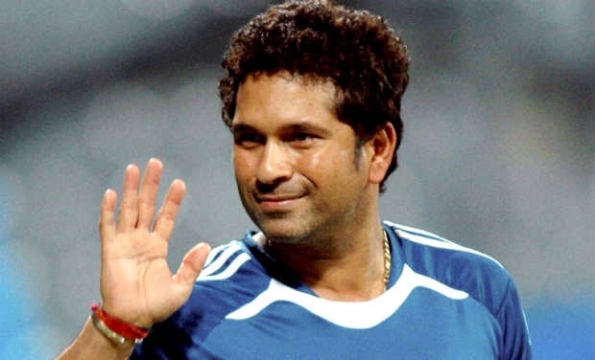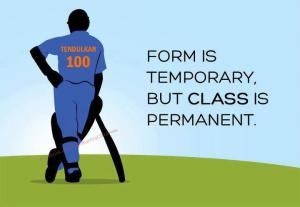Archive
An end of an Innings… Sachin Tendulkar
Sachin Tendulkar has been the greatest sports icon for India and he inspired Indians from all walks of life. I am just one among the millions who love, admire and awed by the talent of Sachin Tendulkar on the cricketing field. For long time he was the only sports superstar that we had to boast about. Saying this I am not trying to ignore the accolades of our other sporting stars like Vishwanathan Anand, Vijay Amritraj, Prakash Padukone, Milka singh, PT Usha and others. While they were great none of them achieved anything close to what Sachin has achieved in their respective sports. They were always the brides maid never the bride. We can argue at length that cricket has much more budgets, funds and support than any other sport in India, but the fact remains that we are a cricket crazy nation and that is the only sport where we compete at the highest level. Other than cricket I can not really think of any sport where we would be called a top class team. So why crib?
While there are few skeptics out there who believe that there are other who were better than him; that he only plays for records or he should have retired couple of years back, I choose to ignore them as people who speak without out facts in hand.For those who play the tune that Sachin was never a match winner and played for his centuries, pls check this analysis of his win ratio for those games he hit a century, the links are given below.
(“Another Sachin century, another match India couldn’t win…” is there merit in that statistic.)
Centuries going down the drain….Sachin and his 12 non productive centuries
Those who are convinced that he plays for the records, I just want to add “he plays and the records follow him”. What i really like about Sachin Tendulkar is his humility. The fact that he has been humble all his live even after what he has acheived is in itself a great achievement as a human being.In the two decades we have not come come across any controversy, loose gossip or incidents that have always been associated with super stars.He is always calm, composed and always speaks with dignity that befitted someone who is not only a great sportstar but a good human too. He is someone who can be a sporting idol for current generation and generations to come.
As his innings comes to a close and and he walks back in to the pavilion one last time, I t hought is is just right to compile all that he has achieved on the green circle. Given below are 200 facts about Sachin that you may like to know.
hought is is just right to compile all that he has achieved on the green circle. Given below are 200 facts about Sachin that you may like to know.
(Compiled from internet)
1. His father named him after the legendary music director Sachin Dev Burman.
2. During his school days, he grew his hair and tied a band around it to copy his idol, tennis legend John McEnroe.
3. While growing up, Sachin would ask his friend Ramesh Pardhe to dip a rubber ball in water and hurl it at him to see the wet marks left on the bat to know whether he had middled the ball!
The Rape Culture….
The recent Rape of a Delhi Girl and the subsequent outrage in the sections of the society is something that we have got used to. Our general fear and subsequent apathy to the such crime has become so deep rooted into our culture, it seem routine. I have found the below article online and it is one of the best essays on the subject. I hope it will help us be more sensitive and one day we will do something more concrete about it.
New Delhi: There has been a slew of responses to the recent rape of a woman in Delhi and the brutal attack on her male friend. Derek O Brien expresses fear for his daughter’s safety, Salman Khan at a press conference to promote his latest film says that he thinks the rapists should be killed, and parliamentarians demand the death penalty for rape. However, these responses and the media coverage on the incident seem to be marked by a refusal to think about the conditions that allow for rape to happen and how we even think of ‘rape’ itself.
It is almost as though the rape legitimates increased control by the family, community and other custodians of women as it brutally enacts the fantasy of a dark and unsafe city where a woman cannot negotiate the streets without being gruesomely violated.
The continuum between the family (the place of safety for women, the home where one is taken care of) and the rape have to be stressed: both are fantasies of control, of doing whatever it takes to keep women in their place, wherever that place is. The elaborate everyday control of women’s lives by families and institutions (both will find increased legitimacy because of the rape) is as systematic, planned and violent as this rape was.
An image of an uncontrolled horde is brought forth by a gang rape – but other groups – families, religious groups, communities that police sexuality are seen as the very essence of civilisation and civility.
The rape of women is seen as aberrant, as outside of the framework of what can be thought, thus the continuous comparison of rapists with animals. However, this very construction of the rape as an event that cannot be understood shows the refusal to see, or act against, brutal everyday forms of control.
We need to stress the continuum between people who rape, people who judge those who get raped, and people who try to protect the women in their lives from getting raped by imposing structures of control. The portrayals of the rape of women allow for those men who want to understand themselves as protectors or avengers to do so, they allow for patriarchal structures of control to strengthen themselves and, crucially, they create women as the ‘legitimate’ subjects of rape.
Why is the rape of women not seen in relation to the rape of men and hijras? Even amongst the rapes of women, it is certain kinds of cases that attract attention: marital rape, date rapes and the sexual violence that takes place within the family are systematically ignored.
Sex workers and domestic workers are at the receiving end of systematic sexual violence but the violence faced by them is normalized in the structure of our society, just like certain continual forms of sexual harassment on metros, public transport, schools and universities are seen to be so routine that it is seen to be in bad form to respond to them. Everyday, routine, ‘normal’ sexual practice hardly involves the discussion of consent or what might constitute a violation.
The fantasies of heterosexual love in our popular cultures are fantasies of dominance and submission, our idea of ‘romance’ sexist to say the least. Our idea of sex is so completely dominated by the vision of a penis penetrating a vagina that other kinds of forced penetration and violation do not even get the kind of limited response that such a rape does get.
The fervent responses to those rapes which even become the subject of public/ political discussion, such as demands for violent retribution to be visited upon the rapists are actually more a sign of unconcern rather than an expression of an angry will to change the structures we live in.
They manifest the desire to witness and enact violence (what better when this enactment of violence is legitimated by public discourse). The slow, difficult thinking through, the rigorous and exhausting work required for changing the psychical, economic and social conditions which create the conditions for rape demand much greater commitment and strength than wishes for public lynchings. The danger of feeling legitimated in performing violence on someone else has to be stressed. The rapists also felt ‘outrage’ at the behaviour of woman and her companions, they felt their positions to be legitimate.
We need to move outside the frenzy around rape in order to be able to think about it. The demand for “speedy justice” that is being made can never be effectively satisfied by a police force, government or court because these entities are not outside of or separate from family and community structures that legitimise rape in the first place.
Cases of rape committed by army and police force members, or the impunity afforded by the AFSPA show how they themselves are involved in perpetrating sexual and other violence. The police and the judiciary cannot be given up as structures we turn to with our demands for justice but they will not be the bringers of the transformation we need.
To change the manner in which people occupy public space we need sustained effort and political will. Rape creates many victims – women whose lives will be policed more, public spaces that will exude more fear and threat. We have to take responsibility for being complicit in this through our refusal to question what we cherish – family, heterosexuality, marriage, romance.
In our desire to blame the violated woman who was out after dark watching a film, we forget the gay man who picked up a fuckbuddy and gets robbed by him, the sex worker simply because she or he is one, the migrant worker, the Dalit being put in her/his place, the adivasi resisting mining corporations, the Muslim. Their violation seems so routinised that we even forget to ask why let alone call for public lynchings. We are all rapists of one kind or another, complicit with the rape culture we have created, legitimised and contained through a convenient condemnation of one manifestation of it.
Source SIFYBy Akshi Singh
A Land of Dreams
We live in a land of pipe dreams…dreams that are woven every election year which just fizzles out with time. But we live in the hope that for once we may dream a real dream and continue to sleep for that beautiful dream.
This is one of many dreams woven by our leaders to keep us all in a state of sombre nothingness….
A land of dreams…..
In a land where I live,
to my people I shall give,
a life of bliss,
that none shall miss,
but my hands are tied,
The media has lied,
the judge was bribed,
the Maoist have tried
rains have failed
Trains derailed
Forget not your horrid past
remember my dream, that shall long lastO my fellow countryman, dream a dream
wake-up not from its sombre scheme
………………………………….sunil varma
FDI Cartoons…
This is another curation of FDI cartoons that are circulating on the net to follow up with an earlier blog that I had posted FDI in Retail Sector….The new Tamasha in Town





